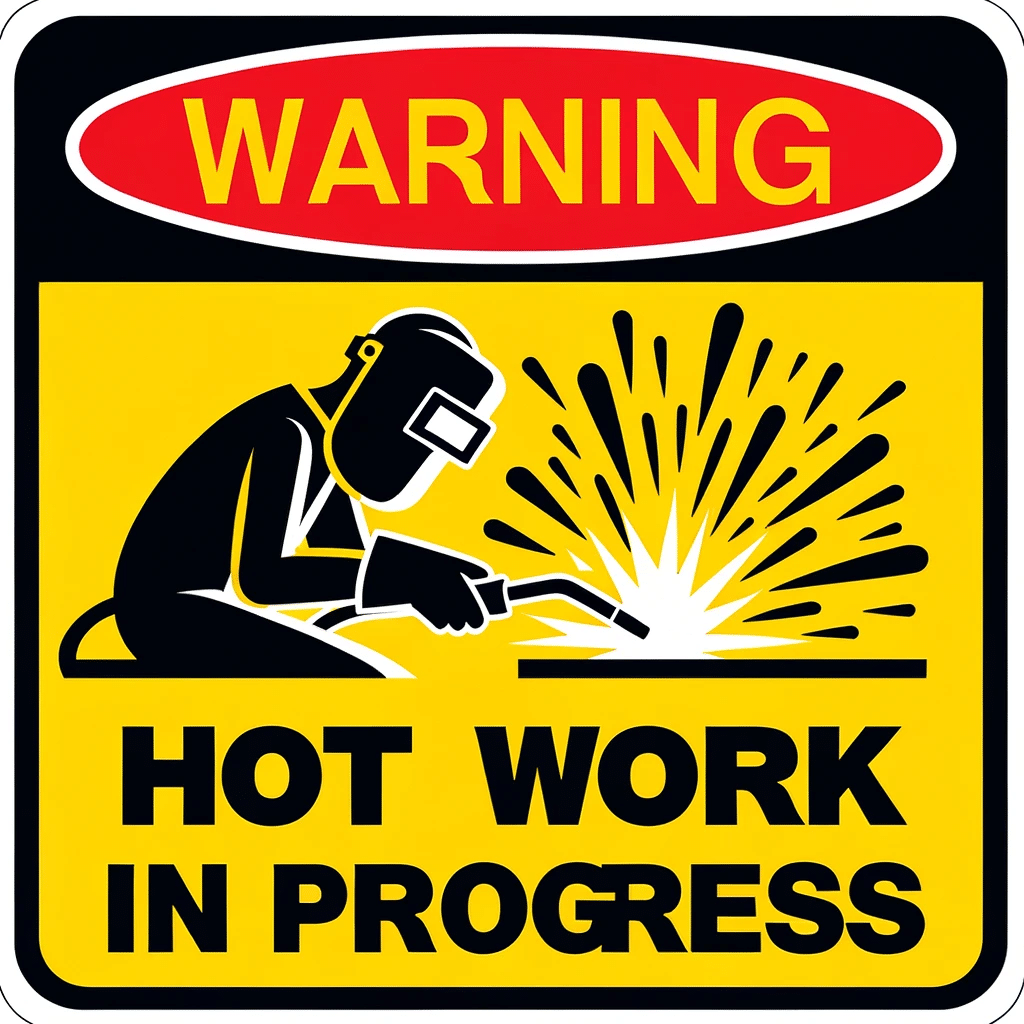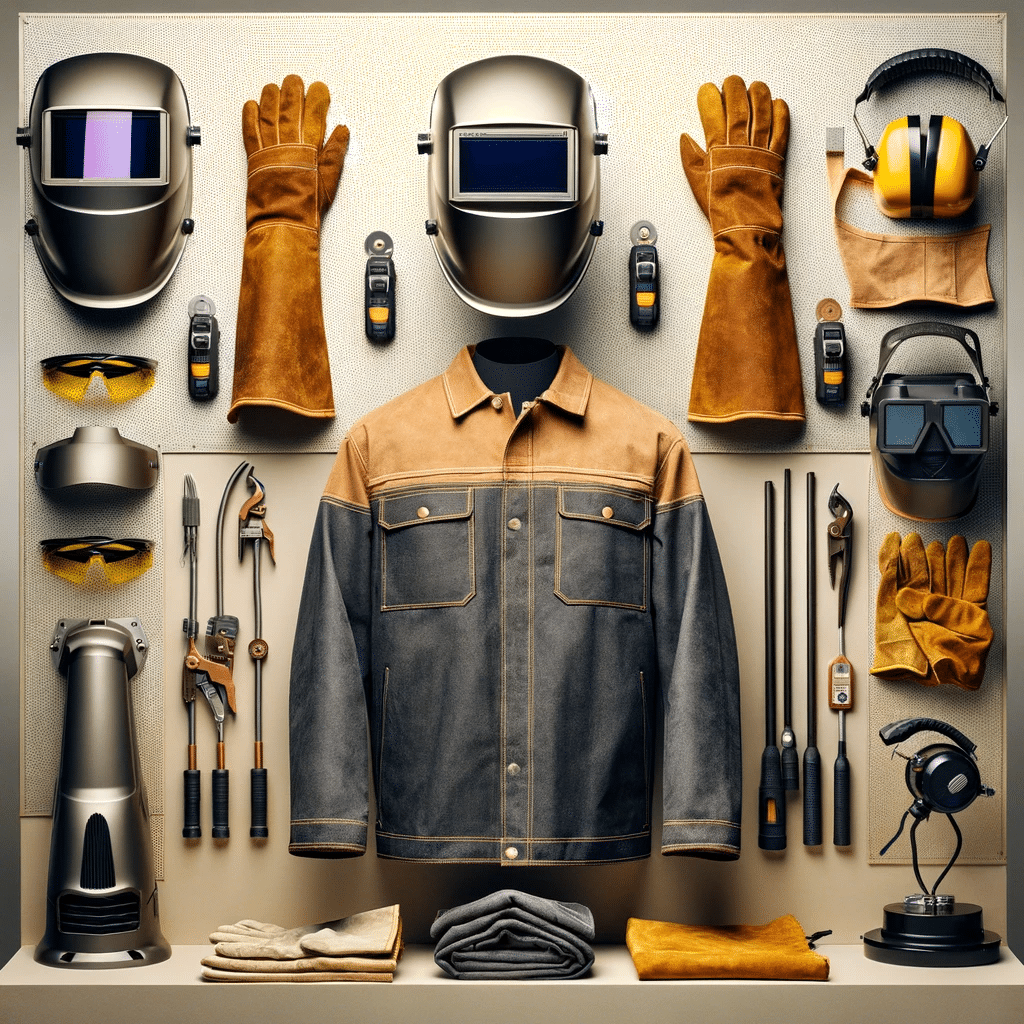What Are the Hazards of Hot Work?

Certain hazards are inherent to all kinds of hot work, so it demands constant application of all necessary safety precautions and controls to avoid accidents.
So, what are the hazards of hot work? Here, we’ll discuss hot work and how to minimize its potential harm.
Also, if you need employee training on hot work, we have a full course.
What is Hot Work?
Tasks like welding and soldering use tools to apply high heat and open flames. They pose serious threats to the health and safety of workers.
The risk involved requires specific safety precautions. Employers must implement controls to protect personnel.

Hot Work Hazards
Hot work hazards describe the dangers of jobs like welding, such as fire hazards from flammable materials.
Hot work operations involve hazards of fire or flashback as well as respiratory, electrical, thermal, and explosive. Common hazards threaten employees, companies, and the work environment.
Significant risk calls for strict measures to prevent fires and injuries while working with open flames, sparks, and hot surfaces.
Examples of Common Hazards
Hazards affect employees and the surrounding environment. Frequent hot work hazards are explosions and fires. A fire can rapidly start if the precautions required are not utilized.
Fire hazards are exacerbated by:
- Sparks that can cause a fire
- Combustible materials and molten metals
- Heated surfaces transfer heat and combust upon contact with hazardous items
- Atmospheric explosions from ignited gases, like hazardous fumes
Associated risks include property damage and personal injury, like burns, respiratory problems, or electric shock. Incidents can also create expensive delays and legal complications.
Hazards may also include exposure to:
- Gases and dangerous fumes can pose serious health hazards; for instance, toxic fumes are created from remaining residues.
- Electrical hazards like live circuits generate high heat and can cause electric shock.
- Infrared or harmful UV light is a hazard, causing skin and eye irritation and damage.
- Open fires and high temperatures can induce symptoms like fainting or heat stroke.
- Equipment safety emergencies can trap, crush, or suffocate workers.

Hot Work Operations
Hot work operations include welding, cutting, grinding, soldering, sawing pipes, and using torch application systems with open flames.
These jobs demand that employers and workers use control measures to maintain overall safety and reduce the risks of fires and other incidents.
Hazards like heated tools and surfaces increase the risk of fire and injury. Before operations begin, a preliminary risk assessment is crucial to identify and implement effective safety precautions.
If an activity is vital to operations, the high-risk level is best managed by using a designated location. The designated hot work area must be properly permitted by local fire authorities.
Hot Work Permits
Hot work permits are a necessary safety measure to mitigate the risks of extreme heat and fire to workers and the work site. With a hot work permit system, activities and equipment are subject to checklists and controls to reduce the safety hazards involved actively.
Formalized control measures are an integral aspect of hot work operations, so the area, equipment, and workers are protected from known health and safety risks.

Establishing a Hot Work Permit System
A permit includes two sections: a tag posted at the job location and another portion maintained on file, audited by management.
Personnel must follow a safety checklist before work begins and once they’ve finished the fire watch.
The permit creates a reliable record of all findings and authorizations specific to the unique tasks and setting. The permit may be canceled in writing once the task is complete.
Information Needed for a Hot Work Permit System
The fire service issues permits and sometimes approves annual permits for qualified contractors to use throughout their jurisdiction.
The following information is needed for a formal permit:
- Permit title and reference, including any other relevant permits
- Job site location and working area description
- Permit date and duration: new shifts may need a new permit
- Equipment being worked on, including applicable identification numbers
- Detailed explanation of the activities being conducted
- Identified hazards and associated risks
- Required precautions, such as proper equipment safety and hazard isolation
- Emergency response arrangements, including rescue equipment details
- Monitoring tools, such as for air quality risks
- Outlined personal protective equipment
- Signature from the managing authority confirming controls, isolations, and precautions are in place.
- A signature from the supervisor confirming the permit, potential hazards, and precautions are understood by all users.
- Shift handover, hand back, and extension notes so new supervisors can confirm all permit information has been conveyed and required testing performed to ensure safety.
- A cancellation signature to confirm the permitted activities are completed, leaving the location safe
Permitting provides an established communication tool for activities with specified risks. It’s part of the risk assessment process needed to facilitate the safest working area possible.
A permit ensures, through a formal written system, that activities and protocols are outlined and adhered to. It communicates vital control measures to address present hazards.
Full procedures for permit issuance can be found within NFPA 51B, which exists to prevent fires and safeguard workers.

Use a Designated Hot Work Area
Fire services must approve the designated location prior to any hot work conducted.
Hot work safety in such areas is improved by:
- Removing all combustible materials
- Checking for unprotected areas where sparks can fly
- Informing all personnel of present hazards and potential exposure risks
Trained workers entering the area can review the permit for equipment and procedure guidelines. This helps keep employees safe while welding, working with an open flame, or doing any other high-risk activity.
Hot Work Safety Precautions
To avoid common risks, workers should regularly renew training and remain versed in all health and safety tips. Moreover, all operations and areas must undergo strict assessments for hazard identification and mitigation.
Hot Work Control Measures
Workers must be fully informed of the risk assessment, permit, and safe systems prior to engaging in activities that will generate heat, sparks, or welding fumes.
Employers have a legal obligation to address all present risks and hazards and to protect workers with appropriate controls.
Controls may be guided by the following hierarchy:
- Eliminate activities altogether if there is no specific need for these operations
- Substitute for less risky alternatives.
- Engineer controls to provide physical solutions for lowered risk levels, like local exhaust ventilation
- Implement administrative controls, such as personnel training
- Finally, use personal protective equipment (PPE) to address residual risks
Determine Emergency Arrangements
Emergency arrangements should be made beforehand and consistently maintained. Specific hot work activities and the known working area must be outlined well in advance, including emergency protocols.
Routinely test alarms and communication systems. Perform shutdown procedure drills in case operations must be halted. Rescue gear should be provided to trained rescue workers. Work area hazards must be considered to avoid combustion and apply appropriate firefighting methods.
It’s also important to collaborate with off-site emergency services in making advanced arrangements.
Basic Safety Procedures
Employers must provide a safe work environment, and safe systems of work (SSoW) play a significant role in risk assessment and hazard control measures.
Proper SSoW will cover the following:
- The setting should be safe for the activities to be performed.
- Only the safest tools and equipment must be permitted for use.
- Only the safest possible substances should be allowed.
- Workers in leadership roles must be competent in performing supervision and monitoring duties, including fully understanding the hazards inherent to the specific activities and work area.
- Employees and personnel must be trained in the safe use of equipment and rescue arrangements as part of a comprehensive safe system of work.

Personal Protective Equipment (PPE)
Personal protective equipment is often necessary to better preserve the safety of workers. The use of suitable equipment is key to minimizing the present and potential dangers.
PPE can include:
- Flame-resistant gloves, aprons, and leggings
- Ear protection
- Respiratory protective equipment
- Face and eye protection
National Safety Standards
The National Fire Protection Association calculates that the fire department responds to thousands of hot work-related structural fires annually. The dangers of hot work are even greater in the presence of combustible or flammable materials.
Resources provided by EH&S can further guide safety measures for hot work operations. To avoid injuries and property damage due to costly accidents, known hazards must be vigilantly minimized with thorough control measures and effective safety precautions.
Common guidelines include:
- Obtaining a permit and adhering to the outlined permit-to-work procedures
- Ensuring no flammable substances or vapors are present and the Lower Explosive Limit (LEL) level is zero before beginning hot work
- Gas testing with total isolation from hazardous flammables
- Dedicating a hot work location, such as a welding booth equipped with fire blankets, to minimize the risk of spreading sparks or flames
- Elevated work protection with fire blanket coverage and barricaded access to avoid flying sparks in spatter fall areas
- Using safety guidelines for storage and handling of compressed gas cylinders to prevent leaks
- Following good housekeeping measures for keeping hot work areas clear of all flammable and combustible materials and substances
- Appropriate fire extinguishers equipped with dry chemical powder (DCP) should be immediately available as part of a routinely maintained workspace
- A trained fire watch employee should remain in position during and following tasks and monitor hot work activities in the permitted area.
- Equipment must be regularly inspected, in working order, and properly positioned for unobstructed access to necessary passageways.
- Prevent spark ignition hazards with spark arrestors in live plant areas
- Ensure all other equipment and cables are in good condition and properly suspended at a sufficient, safe height
Keep Workers Safe From the Hazards of Hot Work
The benefits of hot work operations must outweigh the potential for property damage and personal injury that could be caused by the hot work activity. When possible, avoiding hot work entirely is the most effective way to remain safe from its main hazards.
All other alternatives should be considered before beginning hot work operations, for example, if an item can be more safely replaced than repaired if bolting can be done in lieu of welding, or if safer tools and equipment can substitute torch cutting.
Sometimes, however, hot work cannot be avoided, so additional protection and control measures must be used to promote safety and reduce the risk of fire or explosion.
Only when the area has been thoroughly inspected and outfitted with comprehensive controls can welding or working with sparks and high heat safely commence.
Frequently Asked Questions
What are the hazards of welding and hot work?
Tasks like welding are dangerous, risking fire and explosion. Proper safety procedures should be in place before undertaking these activities.
What are the precautions of hot work?
A hot work permit and employee training are both hazard precautions. Well-prepared workers are significantly less likely to experience injury.
What is an example of a hot surface hazard?
Heated surfaces can start a fire when they come into contact with flammable substances.